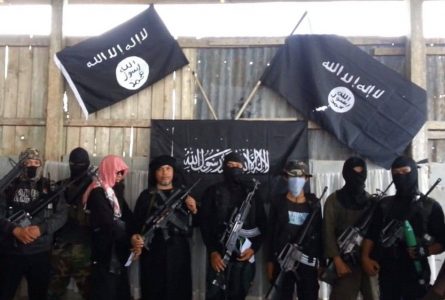
Islamic State terror risk to rise in south Philippines
Philippine President Rodrigo Duterte’s decision to lift martial law in 2020 on the southern island of Mindanao was met with a bang on December 22, when Islamic State (ISIS)-aligned militants launched a brazen grenade attack near a Catholic church.
Two motorcycle-riding assailants, later identified as members of the ISIS-linked Bangsamoro Islamic Freedom Fighters (BIFF), lobbed the bomb at security forces near the church, injuring nine in the low-grade blast.
Moments later, two explosions rocked the nearby townships of Libungan and Upi, hurting 12 civilians.
The explosions came on the eve of Duterte’s scheduled visit to the city, the de facto capital of the new autonomous Bangsamoro region created as part of peace deal reached between the government and the rebel Moro Islamic Liberation Front (MILF).
They also came just days before martial law is set to be lifted across Mindanao, a move some analysts and observers fear could revive dormant ISIS-allied terror groups known to be active on the island.
The security establishment recently advised Duterte against extending martial law beyond 2019, on the grounds that the peace and security situation in Mindanao had substantially improved.
Locals have agitated against martial law’s curbs on liberties, including night-time curfews. But the recent grenade attacks show that local terror groups are poised to regroup and revive with the upcoming removal of the restrictions.
After the December 22 blasts, Duterte traveled to the region for the first ceremonial distribution of Bangsamoro land titles to former MILF fighters, part of a 2014 peace accord that the leader has championed to end decades of debilitating civil war.
That peace deal agreed to create the new Bangsamoro Autonomous Region in Muslim Mindanao, known as BARMM, which was finally formally established in 2019 in the heart of a region where various ISIS-backed terror groups operate.
The BIFF, the group held responsible for the December 20 attacks, is a breakaway faction of the MILF that disagreed with the leadership’s decision to enter a peace deal with the government.
Bangsamoro is home to some four million Muslim Filipinos and is the archipelagic nation’s poorest region. That underdevelopment is a legacy of decades of civil war, where over 120,000 were killed during the government-MILF conflict.
In a December 23 speech, Duterte admitted that ISIS-affiliated groups continue to pose a threat to peace and stability. In response, he agreed to allow the new autonomous Bangsamoro government to establish its own military and police forces, contrary to the original peace deal that said security forces should remain under the national government.
“You arm yourselves but you know you have to kill the terrorists,” Duterte said to Murad Ebrahim, interim chief minister of the Bangsamoro region and concurrent MILF chairman, during the same speech.
Duterte, the first president to hail from Mindanao, also urged Bangsamoro leaders to take advantage of his remaining two plus years in office to implement policies that consolidate peace and promote economic development.
That, however, may be easier said than done with various ISIS-aligned groups lingering in the wings and keen to spoil the peace.
Rommel Banlaoi, chairman of the Philippine Institute for Peace, Violence and Terrorism Research, a Philippines-based think tank, believes that terrorism-related violence will plague the new Bangsamoro region in 2020 and beyond.
He notes that the BIFF and Abu Sayyaf Group (ASG), another ISIS-aligned extremist group classified by the United States as a foreign terrorist organization involved in kidnappings and bombings, are both still active and known to be recruiting in the region. Several other local militant groups have declared loyalty to ISIS in recent years.
Banlaoi believes BIFF militants aimed to taunt Duterte as well as the new BARMM government by launching the grenade attack before the president’s visit.
“Doing it on the eve of Duterte’s visit was conveying a message of continuing defiance against his leadership and against the new political entity in Muslim Mindanao,” the analyst told Asia Times.
ISIS ideology, which employs violence in the name of religion to achieve its ends, including the creation of a caliphate in Southeast Asia, is clearly alive and still spreading in the Bangsamoro region after the ISIS-instigated 2017 siege of Marawi, the country’s only Muslim majority city, Banlaoi said.
The five-month war left the core of Marawi in rubble, killed an estimated 1,100 individuals, mostly militants, and uprooted over 350,000 civilians, of whom 66,000 remain in temporary shelters.
Banlaoi said he expects ISIS militants to sustain and potentially intensify their attacks on military and other symbolic targets in 2020 after martial law is lifted.
Both the Philippine military and the police have asked the public to remain vigilant of potential terror threats and report unusual items or suspicious persons to authorities.
But ISIS-allied groups continue to adapt their tactics to avoid detection and recruit new members. That has been seen in recent suicide bombings that have resorted to using radicalized youth to perpetrate attacks.
“Juvenile suicide terrorism will become a global trend in the years to come if not prevented,” Banlaoi warned.
He notes that the children of a radicalized Indonesian couple who launched a lethal suicide bomb attack on a Catholic church in southern Jolo were found to be trained to carry out future such attacks.
Source: Asia Times





